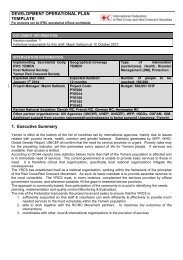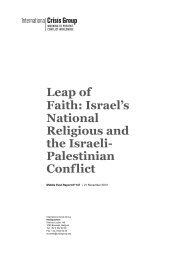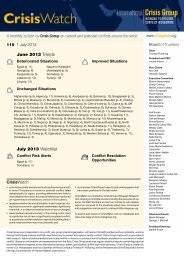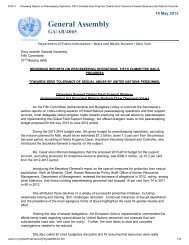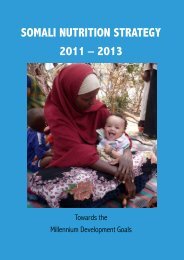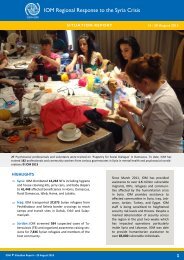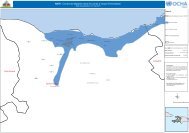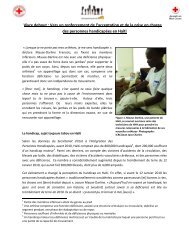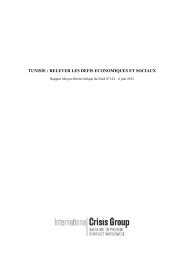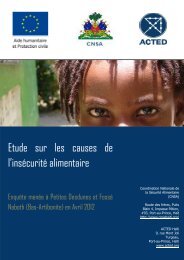issues for consideration at the berlin donor conference ... - ReliefWeb
issues for consideration at the berlin donor conference ... - ReliefWeb
issues for consideration at the berlin donor conference ... - ReliefWeb
Create successful ePaper yourself
Turn your PDF publications into a flip-book with our unique Google optimized e-Paper software.
12 THE ROAD AHEAD<br />
PILLAR TWO OF THE NATIONAL DEVELOPMENT FRAMEWORK:<br />
REBUILDING INFRASTRUCTURE<br />
The second pillar of <strong>the</strong> NDF addresses physical infrastructure and n<strong>at</strong>ural resources. The aim of<br />
this pillar is to leverage external assistance to build or rebuild Afghanistan’s infrastructure, and to<br />
develop its n<strong>at</strong>ural resources in order to lay <strong>the</strong> found<strong>at</strong>ion <strong>for</strong> sustainable growth led by <strong>the</strong> priv<strong>at</strong>e<br />
sector. Fifty-two percent of <strong>the</strong> total $27.6 billion requested by <strong>the</strong> government in its 2004-2011<br />
n<strong>at</strong>ional development budget is <strong>for</strong> development in this sector. 62 As envisioned by <strong>the</strong> Afghan<br />
government, <strong>the</strong> activities and programs th<strong>at</strong> fall under this pillar are: transport and<br />
communic<strong>at</strong>ions, w<strong>at</strong>er and sanit<strong>at</strong>ion, energy, urban management, and n<strong>at</strong>ural resource<br />
management. The government has prioritized funding <strong>for</strong> <strong>the</strong> transport and communic<strong>at</strong>ions<br />
sectors—$7.5 billion out of <strong>the</strong> total pillar II request of $14.4 billion—and those are <strong>the</strong> two <strong>issues</strong><br />
covered here. Seventy-nine percent of <strong>the</strong> funds requested <strong>for</strong> <strong>the</strong> transport sector are <strong>for</strong> road<br />
rehabilit<strong>at</strong>ion.<br />
Ethnic conflicts, geographic terrain, factionalism, and different languages all contribute to<br />
fragment<strong>at</strong>ion within Afghan society. Connectivity, both internally and externally, is a central <strong>the</strong>me<br />
in <strong>the</strong> reconstruction process of Afghanistan. Indeed, <strong>the</strong> n<strong>at</strong>ural str<strong>at</strong>egic potential of Afghanistan<br />
lies in its position as a trans-Asian link. As Afghanistan’s vice-president, Heday<strong>at</strong> Amin Arsala, has<br />
said, “My dream is <strong>for</strong> Afghanistan to rediscover its role as a bridge.” 63<br />
TRANSPORTATION<br />
The NDF focuses on restoring and cre<strong>at</strong>ing basic transport infrastructure to allow better oper<strong>at</strong>ion<br />
of necessary public and priv<strong>at</strong>e transport services in all areas of <strong>the</strong> country. The government hopes<br />
th<strong>at</strong> intern<strong>at</strong>ional linkages will facilit<strong>at</strong>e economic development by improving access to markets,<br />
potentially impacting Afghan poverty levels. The program focuses on specific interventions in<br />
primary and secondary roads, civil avi<strong>at</strong>ion infrastructure, and essential public transport.<br />
Exploiting its geographic loc<strong>at</strong>ion as a trans-Asian trade and transport<strong>at</strong>ion route would establish<br />
Afghanistan as a viable intern<strong>at</strong>ional player, contributing to its prosperity and to regional political<br />
and economic development. Afghanistan will not realize its economic potential until goods can be<br />
more easily and reliably transported through <strong>the</strong> country. Transport<strong>at</strong>ion systems will also enhance<br />
<strong>the</strong> ability of customs officials to monitor and tax goods moving through <strong>the</strong> country.<br />
Physically connecting <strong>the</strong> dispar<strong>at</strong>e ethnic groups in Afghanistan, separ<strong>at</strong>ed by language, geography<br />
and varying local governance structures will decrease levels of fear and tension between <strong>the</strong> groups<br />
and will be essential to <strong>the</strong> central government’s ef<strong>for</strong>ts to assert its role. Ministers in Kabul rarely<br />
leave <strong>the</strong> city limits, as travel within <strong>the</strong> country is unsafe and time-consuming. The recent<br />
assassin<strong>at</strong>ion in Her<strong>at</strong> of <strong>the</strong> minister of civil avi<strong>at</strong>ion and tourism is <strong>the</strong> second assassin<strong>at</strong>ion of a<br />
minister of civil avi<strong>at</strong>ion and tourism, and <strong>the</strong> third assassin<strong>at</strong>ion of a minister in two years. 64 (It<br />
followed a failed assassin<strong>at</strong>ion <strong>at</strong>tempt on Ismail Khan, Her<strong>at</strong> province’s governor and Sadiq’s<br />
f<strong>at</strong>her.)<br />
62 See Appendix C <strong>for</strong> a sector breakdown of <strong>the</strong> 2004-2011 N<strong>at</strong>ional Development Budget.<br />
63 Raja C. Mohan, “India and Afghan Railroads,” The Hindu, February 20, 2003,<br />
.<br />
64 Amy Waldman, “Official Killed as Strife Grows in Afghanistan,” The New York Times, March 22, 2004.




